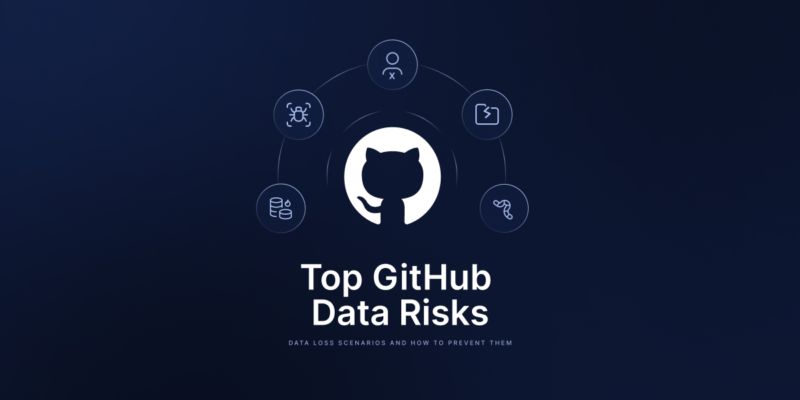
Top 14 GitHub Data Risks: Data Loss Scenarios and How to Prevent Them
While GitHub offers robust features, preventing data loss risks requires proactive measures. It’s vital as businesses increasingly rely on GitHub for source code management, safeguarding repositories against data loss, breaches, and operational disruptions.
This overview explores the 15 most common data risks and provides actionable strategies for securing repositories and maintaining seamless development workflows.
Risk 1. Accidental deletion of repositories
Despite technological advancements, human error remains a significant cause of data loss. Developers or admins can accidentally delete repositories or critical files. It may not only erase weeks or months of work but also compromise trust in the version control system.
To prevent accidental repo deletion:
- enable soft delete if possible (for example, archive repositories instead)
- implement repository backups using tools like GitHub API or third-party solutions like GitProtect.io
- utilize branch protection rules to safeguard critical branches.
In addition, restrict deletion permissions to admins or trusted roles. Enable logging and real-time alerts for repository deletions to track changes and respond quickly.
Risk 2. Overwritten data during force push
The git push –force command overwrites history, erasing prior contributions and sensitive data. If not addressed promptly, it leaves no way to recover.
To avoid the risk of git push –force related data overwrites:
- turn off (disable) force push on protected branches – set rules to disallow force pushes on critical branches, such as main or release (preserve commit history)
- utilize tools like the git reflog command to recover lost commits when necessary
- implement Git hooks or CI pipelines to detect and warn about potentially harmful force pushes (pre-push hooks), prompting a review before execution.
Developers should be trained on the impact of forced updates and encouraged to carefully review them before executing them.
Risk 3. Compromised credentials and security vulnerabilities
Compromised credentials or leaked API keys grant attackers unauthorized access to repositories. That can obviously lead to security incidents:
- repo hijacking
- code tampering or deletion
- data breaches
- organization reputation loss.
Recommended countermeasures require you to:
- rotate credentials (and tokens) regularly
- use GitHub Actions secrets or secret management tools (third-party)
- monitor repository activities with audit logs to detect anomalies or unauthorized actions (access) quickly.
DID YOU KNOW…?
GitHub users had exposed 12.8 million authentication and sensitive secrets across 3 million public repositories in the United States (alone) in 2023.
Source: sisainfosec.com
Risk 4. Insider threats
Whether malicious or accidental, insider threats represent a substantial risk of sensitive data and critical resource exposure.
If neglected, the problem can disturb your company with:
- financial losses
- damaged morale within an organization due to breached trust.
To minimize the risk, it’s vital to:
- implement a least-privilege access policy and grant access strictly based on role requirements and operational necessity – regularly review permissions for compliance and minimize exposure of sensitive assets
- utilize audit logs and monitoring to track user activities: file access, edits, or deletions – use anomaly detection to identify unusual behaviors like bulk data downloads or unauthorized access attempts
- develop strict offboarding procedures (protocols) to revoke all access promptly – use automated tools to ensure thorough de-provisioning of permissions across platforms.
Your staff needs to be educated on best practices for data protection, such as mandatory multifactor authentication (MFA) and others.
Risk 5. Repository corruption
Unsurprisingly, files in GitHub repositories may become corrupt due to:
- issues (malfunctioning version control, faulty IDEs, or text editors)
- vulnerable dependencies (outdated libraries, malicious dependencies)
- incomplete commits (accidental stage and commit, force push, interrupted commit process)
- errors (merge conflicts, corrupted .git directory, file transfer errors, storage device failures).
All these threaten the loss of essential resources.
To prevent the repo corruption, you need to:
- maintain regular offsite backups (e.g., with GitProtect backup and DR software for GitHub)
- verify repository integrity using tools like git fsck
- integrate checks into CI/CD pipelines to identify potential corruption before deployment.
Risk 6. Ransomware or malware attacks
Malicious software-related actors may encrypt or corrupt data stored in the repositories (codebase) through malware or ransomware attacks.
That means ransom demands or complete project losses may occur without proper recovery mechanisms.
Dealing with threats includes a few steps:
- using version control snapshots to roll back changes
- ensuring endpoint security with antivirus and firewalls
- maintaining immutable backups of repositories.
DID YOU KNOW…?
An analysis of over 19,000 custom GitHub Actions showed that only about 900 (4.74%) were created by verified users.
Source: okoone.com
Risk 7. Dependence on a single maintainer
When a single user manages a critical repository, his unavailability could lead to operational bottlenecks. For example, a maintainer’s absence due to illness or resignation can stall progress, creating a knowledge gap.
Further, delays in accessing critical projects can disturb business growth and create information silos.
The solution lies in:
- using multiple administrators (with succession planning) for critical GitHub repositories
- dependency managing with tools like npm, pip, or yarn to ensure that updates are applied regularly
- documenting processes, workflows, and critical systems to establish knowledge transfer (avoiding information silos)
- cross-training teams to handle essential tasks
It’s good to foster strong community engagement around repos and develop emergency procedures at the same time.
Risk 8. API rate limit exhaustion
Overusing API calls may result in blocked requests, data exposure, or partial data loss during automated operations. Incomplete processes tend to end in unsaved changes or unsynced backups, leaving gaps in data.
The prevention method requires you to:
- monitor API usage and activity through GitHub Enterprise Cloud tools to stay within rate limits
- cache frequently accessed data to reduce API load (requests)
- spread operations across time intervals to balance API load.
Consider using Personal Access Tokens (PATs) to authenticate API requests. It will help you manage rate limits more effectively, as PATs often have higher rate limits than anonymous requests.
Risk 9. Lack of backup and disaster recovery plans
Many companies and organizations lack structured mechanisms for recovering data in case of a data breach, making the process even more time-consuming. It can affect business development as well as the company’s reputation and competitiveness.
A straightforward way to avoid such a problem is to:
- follow backup best practices to make sure that your backup strategy is effective
- use automated backup solutions, such as GitHub’s built-in services or third-party tools like GitProtect (with data replication capabilities)
- implement repository replication to maintain additional copies on alternative platforms (e.g., S3 cloud storages or on-premises servers)
- retain multiple backup versions with appropriate retention policies to safeguard against data loss from incremental changes or delayed detection of corruption
- develop disaster recovery strategy with escalation procedures, roles, and communication plans to minimize downtime and expedite resolution during incidents
- test backup restoration regularly.
DID YOU KNOW…?
You can make the backup and recovery process convenient and, above all, safe. Using GitProtect.io, you can:
– automate all DevOps stack backups
– connect any storage for replication (!)
– utilize Instant Remediation Center service (backup assurance with notifications, audit-ready SLA reporting, and visual stats)
– rely on unlimited retention for compliance.
Try for free | Custom demo
Risk 10. Unsecured GitHub Actions workflows
Poorly secured and misconfigured workflows allow attackers to execute unauthorized commands, including data breaches or tampering. Even a single malicious action can compromise the integrity of all repositories and related infrastructure.
Dealing with the risk involves:
- restricting workflows to specific branches to run only on trusted ones (e.g., main or develop)
- reviewing permissions for GitHub Actions runners to avoid unnecessary privileges
- use tools like CodeQL or third-party scanners to analyze GitHub Actions workflows for misconfigurations, hardcoded secrets, or other vulnerabilities
- store sensitive data, such as API keys or tokens, using (securely) GitHub’s encrypted secrets feature
- monitor audit logs to track workflow execution and detect unauthorized activity.
Risk 11. Mismanagement of forked repositories
Forks may have critical changes that are not merged, backed up, or regularly synced with upstream repositories. Consequently, teams can lose key contributions or fixes made in forks, leading to inefficiencies and repeated work.
That means you need to:
- sync forks with upstream repositories regularly, e.g., using commands like git fetch upstream and git merge upstream/main (to keep forks aligned and reduce integration challenges)
- encourage contributors to submit pull requests for changes made in the work
- monitor fork usage and merge significant updates
- provide clear guidelines for forking, syncing, and contributing back to the original repository to foster consistent practices
- establish automated backup strategies for forks with essential updates.
Risk 12. Third-party integration vulnerabilities
Merging changes without proper conflict resolution might result in overwhelming, uncommitted, unsynced, or untracked data. That raises the risk of losing valuable contributions, resulting in rework and delays in release cycles.
To solve the problem, teams need to:
- perform merges locally and test for compatibility before pushing to the main branch
- use feature branches and ensure regular syncs with main branches
- use CI/CD pipelines to test merge operations and flag conflicts early
- train developers on best practices for merge conflict resolution
- clear commit messages to make conflict resolution easier (provide context for changes)
- conduct role reviews before merging to identify potential conflicts and discuss countermeasures in the team.
Risk 13. Data exposure through public repositories
Accidental commits of sensitive data like credentials or API keys to public repositories expose them to exploitation, resulting in financial loss or legal consequences. Third parties can also remove or cache your data.
To prevent the above:
- use secret scanning to detect and flag sensitive information in code automatically
- set repositories to private by default when handling sensitive data
- utilize pre-commit hooks to block accidental commits of secrets
- use tools like BFG Repo-Cleaner or git filter-repo to remove committed sensitive data and rotate exposed credentials to prevent misuse immediately.
Risk 14. Unexpected GitHub service outages
Downtime or outages on GitHub may temporarily make repositories inaccessible, disrupting workflows and creating project delays. Teams may miss deadlines without local copies or mirrors.
To avoid the described challenges:
- clone repositories to local or cloud environments regularly
- maintain a mirror of critical repositories on another service like GitLab, Bitbucket or Azure DevOps
- enable offline access by distributing local copies of essential repositories to key team members (they need to be updated regularly to minimize divergence)
- configure CI/CD pipelines to pull code from multiple sources to maintain continuity during outages
- develop a plan to communicate and coordinate team activities during downtime (e.g., assessing roles, restoring repos, etc.).
DID YOU KNOW…?
By Git Statistics 2023, the IT sector has detected around 65.9% of leaks. In contrast, other sectors such as retail, manufacturing, education, science and tech, finance, and insurance accounted for a share of 30.8% of leakage.
Source: coolest-gadgets.com
Summary
If left unaddressed, all the challenges described can result in operational delays, financial losses, and security breaches.
To mitigate these risks, developers, and organizations must follow security best practices and implement
- automated backups
- enforce least-privilege access policies
- secure GitHub Actions workflows
- maintain local or cloud mirrors of critical repositories.
By systematically securing these vulnerabilities, teams can ensure the integrity, availability, and safety of their codebases while minimizing disruptions to development processes.
[FREE TRIAL] Ensure compliant GitHub backup and recovery with a 14-day trial 🚀
[CUSTOM DEMO] Let’s talk about how backup & DR software for GitHub can help you mitigate the risks






